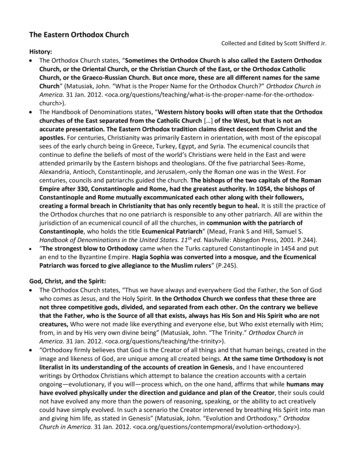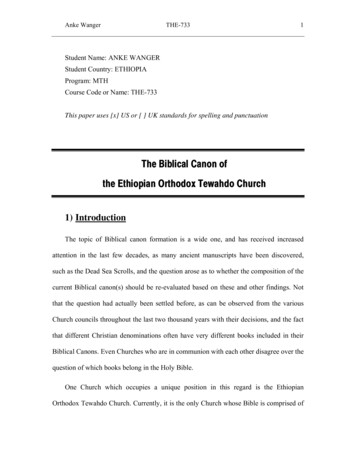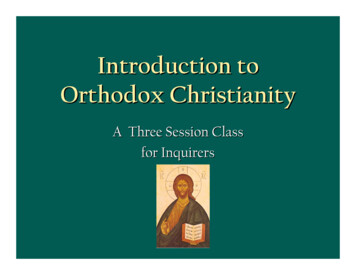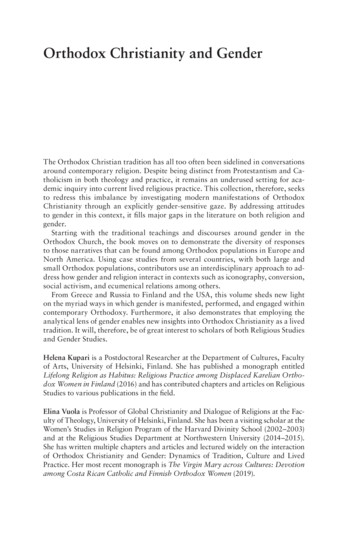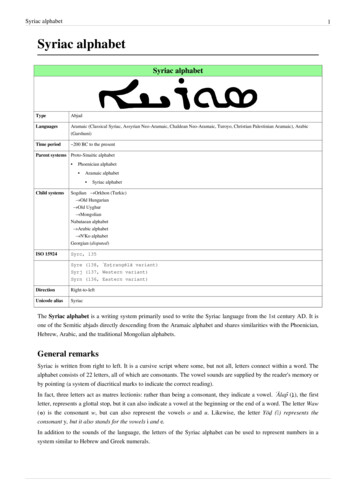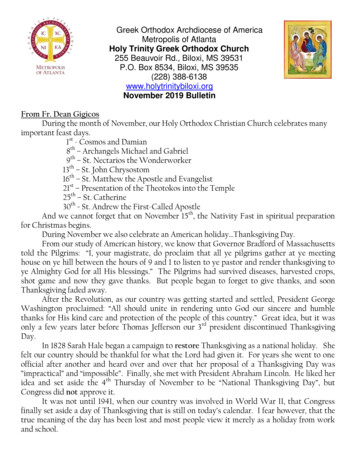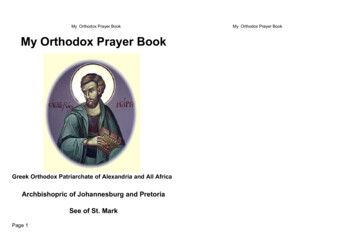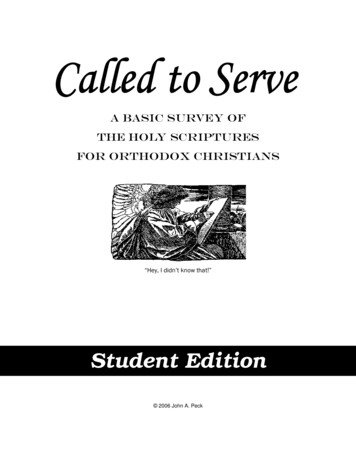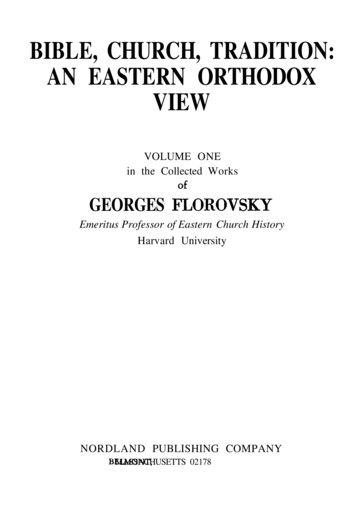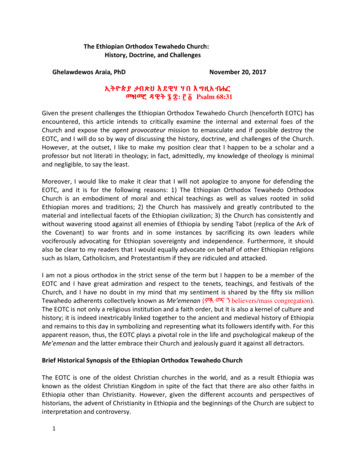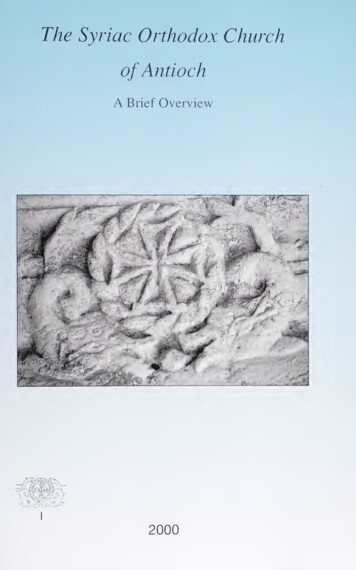
Transcription
The Syriac Orthodox Churchof AntiochA Brief Overview2000
Lt V3 x Hibris?l*ctl) JfHarDtitbo HibrarpThe Malphono George Anton Kiraz CollectionbiiLo. biKaX OiX.nQiw,hj v,v"'v *“:s lAy m vi oou )ooo cnj-io .nmOivtO SLl O ,, . COO L ii.1 -03 OlX looo L OOJOI OJ : Oi ooJ\ OuS, , Soui\ ,X ani.A Anyone who asks for this volume, toread, collate, or copy from it, and whoappropriates it to himself or herself, orcuts anything out of it, should realizethat (s)he will have to give answer beforeGod’s awesome tribunal as if (s)he hadrobbed a sanctuary. Ixt such a person beheld anathema and receive no iorgivenessuntil the book is returned. So be it.Amen! And anyone who removes theseanathemas, digitally or otherwise, shallhimself receive them in double.
fX Anc'\\«Church History: Syriac OrthodoxBeth Mardutho Libraryr OAA )I
Sponsored byAbraham SengulAbraham TekinIssa Aho
His Holiness Moran Mor Ignatius Zakka I IwasSupreme Head of the Syriac Orthodox Church of Antioch
The Syriac Orthodox Church of AntiochA Brief OverviewBvGeorge Anton Kiraz and Thomas JosephPublished byThe Syriac Heritage Committee of the Syriac Orthodox Church2000
Copyright 2000 by The Syriac Heritage Committee.All rights reserv ed.Published by The Syriac Heritage Committee417 E. Fairmount RdBurbank. Ca 91501-1705USATel: (818) 845-5089E-Mail: MorClemisaiaolcomThe emblem of the Committee, shown on the outside cover, is aCross set in a classical laurel wreath which rests on two sea monsterstrying to swallow a pearl. This design appears in the Beth Qadishe,Tlouse of Saints' or burial place, of Deir al-Za'faran, Turkey, andgoes back to the 6 century. The pearl symbolizes the human soul,and the two sea monsters, representmg the grave or death, try toswallow it The wreath around the Cross on top of the sea monstersrepresents Christ's triumph over death The message is: thoseswallowed up by the grave triumph over death with the sign of theCross.
CONTENTSPreface in Syriac.8Preface in English.10Syriac Orthodox Church of Antioch.12History.15Faith and doctrine.22Form of worship.25Church Hierarchy.28Further ReadingBible.30Spirituality.30Liturgy. 31Church History.32Syriac Literature in Translations.33Language. 34
I» QO SloXU iotIso ? » U Uu jjJj —3 paA*mzs. 1lis-. 2l vmDojW—S» IL-2mL.U -Ctw? IK. \.yx L.a aia -isjoioou its\I k p )t x- { aa9—0* 0»oaso. IL. 2ki 3 oo owifl ms cx z o—koaxi L-S of *2l-DoL \- ooK—-L . ILot ?o L »jaco 11*\i o! Vowr L»T»«,V o1 K-V«ra« oif IL »L LiZ oi\L3o 3(L \o3 so»Lit} -o oto—*o L v. K*—* U*L\ o, 11 Ai It—io ltoU-? SO I—. Jlol;'?a 2lcu:Koi Ik \«cr \Lso c* q— i tio\COOu wiLo 0-3os l sfift a \p * —j;ypoaso . } tiois—3* -.7* *— — iv 7 wJ3ot K—\ oLi K- COSO} yOOv lso z ot a *J\ Uo9— ? -L CH oK-3ic -iiljo lK \»cn\ . kavi\ n. L-D SO' . L.V K —so —31 Vrr \ yoooo LdoXsoj—ca co—D*ry.a\ oK—3y.yjaco ioK-3i.8
VILol; O.—-Oi—!.Noir-r 7:} ot a» ) 1 —»iQ—co IL*.?Loa La- ? Lj2 SILoO Ioa.q3olULuli i\A,0\ rrs2\«I-I Q \. / sl ajslC7Ljlooi-i L2 is D Lm IjLs* -O - J \9jlLa.cu i ra\ t r IL .r\e\iUono L\a\r»\-taUI v \I ** S\ioioib * Loy- — O' POI*'O P soill OO IL o ;-2iaj.lUiJ»OOU Uk iO* *L oa o. L- n m , o ,o Ar“ \c.oOL«oo*IQJO lLvIts— « O fV ILol ,OQfl\.-JO»L )0»lis- CO9
PrefaceThe Holy Synod of the Syriac Orthodox Church,held between March 28 and April 3, 2000, decreedthat various committees be formed to strengthen theactivities of the Church. One of these committeeswas The Syriac Language and Heritage Committee,under the chairmanship of His Eminence MorClemis Eugene Kaplan, Metropolitan PatriarchalVicar of the Western United States. As the domainof the said committee is enormous, His Eminencedeemed it appropriate to split the task between twocommittees, one to be concerned with the Syriaclanguage and the other with Syriac heritage.The Syriac Heritage Committee was formedwith three initial members. His Eminence MorClemis Eugene Kaplan, serving as Chairman, theVery Rev. Archpriest Dr. Joseph Tarzi, and DeaconDr George A. Kiraz. An advisory board was alsoformed from renowned scholars in the field ofSyriac, consisting of Dr Sebastian Brock of theUniversity of Oxford, Prof. Rev. Sydney Griffith ofthe Catholic University of America, Prof. SuzanHarvey of Brown University, and Prof. Luk VanRompay of Duke University. His Eminence willappoint additional members to the committee whennecessary.10
One of the initial projects of the Committee isthe publication ot a series on the heritage of theSyriacOrthodoxChurch of Antioch. TheCommittee saw it fit that the first fruit of its workbe a concise overview of the Church, its history,faith and hierarchal tradition, written by Dr. GeorgeA Kiraz and Dr Thomas Joseph, co-editors of du). It is our hope that this overviewwill help in educating our Syriac people who arenow scattered all over the four corners of the earthas a result of immigrationWe pray that this elementary booklet proofbeneficial to our Syriac faithful, please the Lord as asmall service to His people, and be a mean for theexaltation ot the Church and the glorification of theLord's name.July 30th, 2000Feast of St. Jacob BaradaeusThe Syriac Heritage Committeeof the Syriac Orthodox Church11
The Syriac Orthodox Church of AntiochA Brief OverviewA few Christian denominations can claim theantiquity of the Syriac Orthodox Church of Antioch,whose foundation can be traced back to the verydawn of Christianity. The Church justifiably pridesitself as being the earliest established apostolicchurches. It was in Antioch, after all, that thefollowers of Jesus were called Christians as we aretold in the New Testament, “The disciples were firstcalled Christians in Antioch.” (Acts 11:26).According to ecclesiasticaltradition, theChurch of Antioch is the second established churchin Christendom after that of Jerusalem, and theprominenceofits Apostolic See is welldocumented. In his Chronicon (I, 2), the churchhistorian Eusebius of Caesarea tells us that St. Peterthe Apostle established a bishopric in Antioch andbecame its first bishop. He also tells us that St. Peterwas succeeded by Evodius. In another historicalwork. Historic! Ecclesiastica, Eusebius tells us thatIgnatius the Illuminator, “a name of note to mostmen, [was] the second after Peter to the bishopric ofAntioch” (III, 36).In the mid of the 5th century, the Bishop ofAntioch, andhis counterparts in Alexandria,12
Byzantium and Rome, would be called patriarchs.The Syriac Orthodox Patriarch of Antioch used tobe known by his own name; however, since 1293the patriarchs of Antioch adopted the name Ignatius,after Ignatius the Illuminator. The See of Antiochcontinues to flourish till our day, with His HolinessPatriarch Ignatius Zakka I, being the 122nd in theline of legitimate patriarchs.The patriarchate was forced to move fromAntioch in A D. 518, after a period of turbulenthistory, to various locations in the Mesopotamiauntil it settled in Deir az-Za'faran monastery inMardin, Turkey, during the 13th century. Afteranother period of heinous violence during and afterWorld War I, which took the lives of a quartermillion Syriac Orthodox faithful, the Patriarchatewas transferred to Homs, Syria, in 1933, and later toDamascus in 1959.The Syriac Orthodox Church is quite unique formany reasons. Firstly, it presents a form ofChristianity which is Semitic in nature, with aculturenot far from the one Christ himselfexperienced. Secondly, it employs in its liturgy theSyriac language, an Aramaic dialect akin to theAramaic spoken by Christ and the Apostles.Thirdly, its liturgy is one of the most ancient, andhas been handed from one generation to another.Fourthly, and most importantly, it demonstrates the13
unity of the body of Christ by the multiethnic natureof its faithful: A visit to your local Syriac OrthodoxChurch in Europe or the Americas woulddemonstrate, for example, the blend of Near Easternand Indian cultures in the motifs and vestments ofclergy. The Syriac Orthodox faithful today liveprimarily in Middle Eastern countries and theIndian State of Kerala, with many communities inthe diaspora.The Syriac Orthodox Church has been amember of the World Council of Churches since1960, and is one of the founding members of theMiddle East Council of Churches. The Church takespart in ecumenical and theological dialogues withother churches. As a result of these dialogues, theChurch has issued two joint declarations with theRoman Catholic Church and another with theEastern Orthodox churches.The Church has been known in English by thename “Syrian Orthodox Church"’. The Holy Synodof the Church adopted the translation "SyriacOrthodox Church"" in its session of Mar 28-Apr 3,2000 due to the needs of the faithful in the diaspora.14
HistoryThroughout Syria and Mesopotamia, Aramaic, in itsmany dialectical forms, was the language of theland, and Syriac, originally the Aramaic dialect ofEdessa in Northern Mesopotamia, must have beenthe most influential literary form of Aramaic Whenwe speak of Syriac Christianity, we refer toChristians whose native tongue was and still isSyriac, and those who employed Syriac as theirliturgical languageSyriac Christianity was not centered just inAntioch, the Roman capital of Syria In fact, SyriacChristianitycan be traced further East inMesopotamia. As tradition tells us, Christianity wasreceived in Edessa during the time of the ApostlesThis is reported in a number of documents includingEusebius's Ecclesiastical History He gives us thetext ot a correspondence between the city's king,Abgar UkomoHimself:baooland none other than JesusAbgar Ukomo, the toparch, to Jesusthe good Savior who has appeared inthe district of Jerusalem, greetings. Ihave heard concerning you and yourcures, how they are accomplished byyou without drugs and herbs . And15
when I heard of all these thingsconcerning you I decided that it isone of two things, either that you areGod and came down from Heaven todo these things, or are the Son ofGod for doing these things. For thisreason I write to beg you to hasten tome and to heal the suffering which 1have .The reply from Jesus to King Abgar, accordingto the same tradition, was carried by a certainAnanias and read:Blessed are you who believed in me,not having seen me . Nowconcerning what you wrote to me, tocome to you, I must first completehere all for which I was sent, andafter thus completing it be taken upto Him who sent me; and when Ihave been taken up, I will send toyou one of my disciples to heal yoursuffering and give life to you andthose with youThe story continues to describe how one of theSeventy Disciples, named Adai, was sent to KingAbgar to heal his disease16
Historical literary sources tell us that by thesecond half of the second century there was anestablished church in Edessa, though probably mostof the inhabitants remained pagan. The Chronicle ofhJessa tells us that in the year 201, a disastrousflood destroyed the church of the Christians in thecity However, it took only about a century untilmost of the city was under the umbrella ofChristianity Edessa, home of the Syriac form ofAramaic, indeed prides itself as the first Kingdomthat officially accepted the new faithIndia had its own share of Syriac ChristianityAccording to tradition, Christianity in India wasestablished by StIhomas who arrived inMalankara (Kerala) from Edessa in A D 52 Theclose ties between the Church in Malankara and theNear East go back to at least the fourth centurywhen a certain Joseph of Edessa traveled to Indiaand met Christians there The church in Malankaratoday is an integral part of the Syriac OrthodoxChurch with the Patriarch of Antioch as its supremehead 1 he local head of the church in Malankara isthe Catholicose of the East, consecrated by andaccountable to the Patriarch of AntiochSyriac Christianity spread rapidly in the EastThe Bible was translated into Syriac to serve as themain source of teaching as early as the secondcentury fill our day, the antiquity of the Syriaci7
biblical versions is upheld with high esteem bymodern scholars. In the words of Dr. ArthurVoobus, ccIn our search for the oldest translation ofthe Greek original [of the New Testament] we mustgo back to the Syriac idiom” (Studies in the Historyof the Gospel Text in Syriac, p. 1). The SyriacChurch Fathers made no less than six translationsand revisions of the New Testament and at least twoof the Old Testament. Their scholarship in thisdomain has no equal in Church history.The Church of Antioch was thriving under theByzantine Empire until the fifth century whenChristological controversies split the Church. Afterthe Council of Chalcedon in A.D 451, two campsof the one Church emerged: The Greek Church ofByzantium and the Latin Church of Rome acceptedChalcedon, but the Syriac and Coptic (laterArmenian as well) Churches rejected the Council.The former group professed that Christ is in twonatures, human and divine, whilst the latter adoptedthe doctrine that Christ has one incarnate naturefrom two natures. It is worth noting that the draftsof the Council were according to the position of theSyriac and Coptic Churches. The final resolution,however, was according to the doctrine of theWestern Churches and was rejected by the SyriacChurch. This schism had sad consequences on theSyriac Church during the next few centuries.18
As the Emperor supported the Chalcedoniancamp, theSyriac Church came under muchpersecution. Many bishops were sent to exile, mostnotably Patriarch Mor Severius, who was latergiven the epithetL L togho dsuryoye, 'Crownof the Syriacs’. Mor Severius died in exile in 538.By the year 544, the status of the Syriac Churchcame to a low end when only three bishopsremained. It was at this time that Mor JacobBaradaeus appearedMor Jacob traveled toConstantinople tor an audience with EmpressTheodora, the daughter of a Syriac Orthodox priesttromMabbug, according to Syriac Orthodoxsources, and wife of Emperor Justinian. Theodoraused her intluence to get Jacob ordained as bishopin 544. Later, Jacob would travel across the entireland reviving the Church. He managed to consecrate27 bishops and hundreds of priests and deacons. Forthis, the Syriac Orthodox Church honors this sainton July 30 of every year, the commemoration of hisdeath which took place in 578. A few centurieslater, adversaries labeled the Syriac OrthodoxChurch Hacobite" after St. Jacob. The SyriacOrthodox Church rejects this belittling label whichwrongly suggests that the Church was founded bySt. Jacob.Aside from their ecclesiastical role, SyriacChurchmen have contributed to world civilization.19
As early as the fourth century, academies andschools were set up in monasteries throughout Syriaand Mesopotamia. Monks and scholars were busystudying the sciences of the Greeks, commenting onand adding to them. It is no surprise that when theMuslim Arab, who conquered the Near East at theend of the seventh century, wanted to acquire Greekknowledge, they turned to Syriac scholars andchurchmen. Arab caliphs commissioned Syriacscholars to translate the sciences of the Greeks intoArabic.Inhisfilm Forgotten Christians,Christopher Wenner describes the impact of Syriacscholars and Churchmen when he describes theschool at Deir az-Za'faranL, monastery, “Itwas through the monks here that the Arabs receivedGreek learning, and it was the Arabs of course whopassed it back to Europe. Had it not been for theSyriac monks, we in Europe might never have had arenaissance/”The Syriac Orthodox Church survived underthe dominion of many empires in the centuries thatfollowed Under the Arabs, Mongols, Crusades,Mamluks and Ottomans, the Syriac OrthodoxChurch continued its survival. Neither intimidationnor oppression could suppress the faithful, but theChurch diminished in size to a fraction of what itwas.20
By the beginning of the 20th century, SyriacOrthodox Christianity was confined mostly tomountainous rural areas, such as Tur Abdin, andvarious towns in the Ottoman Empire. The last ofthe persecutions was still to come. During WorldWar I, massacres and ethnic cleansing befell theSyriac Orthodox Christians at the hands of theOttoman Turks and the neighboring Kurds. Theyear1915 is known in Syriac by la-m sayfo, or '[theyear of the] sword'. It is estimated that a quarter ofamillion perished, villages were emptied,monasteries and Churches were destroyed. Thisresulted in what the Syriacs call (in Turkish) seferberlik The collective exodus’, a migration to thenewly established countries of Syria, Lebanon, Iraqand Palestine. Some left the Middle East alltogether,forming new communities in theAmericas.As a result of further immigration that ensued,the Syriac Orthodox Church today has faithful notonly in the Middle East and India, but in Europe,the Americas and Australia as well.21
Faith and Doctrine*The faith of the Syriac Orthodox Church is inaccordance with the Nicene Creed It believes in theTrinity, that is one God, subsisting in three separatepersons called the Father, the Son and the HolySpirit The three being of one Essence, of oneGodhead, have one Will, one Work and oneLordship The special aspect of the First Person isHis Fatherhood, that of the Second Person HisSonship, and that of the Third Person HisProcessionAsfor Christology, the Syriac OrthodoxChurch further believes in the mystery ofIncarnation. That is, the Only Son of God, theSecond Person of the Holy Trinity, took to Himselfa body and became man. It further believes that atthe time of Annunciation, when the Angel Gabrielwas sent to the Virgin Mary, the Holy Spirit cameupon her and cleansed her of all natural impurity,filling her with His grace Then the Only Son ofGod came down and entered her immaculate womb,and took to Himself a body through her, thusThis section and the following section are adapted fromEphrem I Barsoum. The Shorter Catechism of the SyrianOrthodox Church of Antioch (repnnted by The Archdiocese ofthe Syrian Orthodox Church for the Eastern United States.1999)'.22
becoming a perfect Man with a perfect Soul. Afternine months. He was born ot her and her virginitywas maintained contrary to the laws of nature Itfurther believes that His true Godhead and His trueManhood were in Him essentially united. He beingone Lord and one Son, and that after the union tookplace in Him, He had but one Nature Incarnate, wasone Person, had one Will and one Work. This unionis marked by being a natural union of persons, freeofall separateness, intermixture, confusion,mingling, change and transformation.The Syriac Orthodox Church calls Mary IA.yoldath a!oho, Bearer ot God’, because shegave birth to Christ, God truly incarnate.The Syriac Orthodox Church believes that thedeath of Christ was the separation of His soul fromHis body, but His divinity did not at any time leaveeither His body or His soul. It further believes thatby His death tor us. He conferred upon us salvationtrom eternal death and reconciliation with HisHeavenly Father.The Syriac Orthodox Church believes that theHoly Spirit is the Third Person of the Holy Trinity,the Spirit of Truth, proceeding from the Father. TheHoly Spirit is equal with the Father and the Son.(Note. The word for 'spirit" in Syriac,Lo,ruho23
(whichis also the word for 'wind’), isgrammatically feminine. Holy Spirit is referred towith the feminine pronoun in almost all early Syriacwritings, though later writings refer to it in themasculine.)It further believes that the church is the body oftrue believers in Christ, and that the Head of thechurch is Our Lord God Jesus Christ The ChiefBishop of the Syriac Orthodox Church is ThePatriarch of Antioch.With regards toSacraments, the SyriacOrthodox Church believes that the Holy Sacramentsare tangible signs designated by the Lord Christ toproclaim divine grace, which He gave for oursanctification. The Sacraments of the Church areseven: Baptism, Holy Chrism (Confirmation),Eucharist, Repentance, the Priesthood, Anointing ofthe Sick, and Marriage. Holy Sacraments areoffered by the Bishops and the Priests. Onlybelievers can receive the Sacraments. All but fourof the Sacraments are essential for salvationBaptism, Holy Chrism (Confirmation), Repentanceand Eucharist Of the sacraments. Baptism, HolyChrism and the Priesthood may be received onlyonceThe Syriac Orthodox Church conforms to theteachings of the Three Ecumenical Councils ofNicea (A D 325), Constantinople (A D 381) and24
Ephesus (A D. 431).Chalcedon (AD 451).Itrejectsthe Council ofForm of WorshipIn accordance with Psalm 119, verse 164, “Seventimes in the day have I praised thee for thyjudgments, O Righteous One,” the Syriac OrthodoxChurch set the times for prayer to seven: Evening orramsho prayer (Vespers), Drawing of the Veilor Uom sootoro prayer (Compline), Midnight orLx\lilyoprayer.Morningorl-Sjsaphro(Mattins), the Third Hour orprayer (Prime, 9 a m ), theprayertloth sho inSixth Hour orsheth sho rn prayer (Sext, noon) and the Ninth Hourorl tshaMidnightsho in prayer (Nones, 3 p.m). Theprayerconsistsof threeqawme'watches’ (literary 'standing’).The ecclesiastical day begins in the evening atsunset. For example, Monday starts at sunset onSundayevening.Hence, Monday's evening(ramsho) and compline (sootoro) prayers, areactually performed on Sunday in our modernreckoning. Today, even in monasteries, the eveningand compline prayers are said together, as also theMidnight and Morning prayers, and the Three, Six25
and Nine O'Clock prayers, reducing the times ofprayer to threeDuring prayers, the worshipper stands facingthe East, holding his hands outspread. (For as thelightning comes from the east and shines as far asthe west, so will be the coming of the Son of man Matthew 24:27.)The sign of the cross is made with the righthand The thumb, first finger and second finger arebrought together and the first finger is extendedfurther than the thumb and second finger, indicatingthat Christ is the One and Only Savior. The sign ofthe cross is drawn starting from the forehead, downto the breast and then from the left to the rightshoulder. This tradition symbolizes that the LordChrist, came down to earth from the heights, andredeemed our earthly body from the gloomy pathsof darkness (left), to the paths of truth and light(right)PublicprayerisimportantChristianity Traditionally, the HolyinSyriacOurbouo,i.e.Eucharist, is celebrated every Sunday,Wednesday and Friday. Presently, only monasteriesobserve the Wednesday and Friday Holy Qurbono.Monasteries, and almost all Churches, observe dailyprayers known asshhimo ‘simple [prayers]’.26
Apart from sermons, all prayers are sung in theform of chants and melodies. Thousands of tunesandmelodies existed, most of which areunfortunately lost. Still hundreds of melodiesremain and these are preserved in the Treasury ofTunes known in Syriac as Beth Gazo. Since amusical notation system was not developed, thetunes were transmitted down the ages as oraltradition. As a result a few schools of musicemerged, most notably Edessa, Diyarbakir, Mardin,Tur Abdin, Kharput, and Homs, name a few.During the celebration of the Eucharist, priestsand deacons put on elaborate vestments which areunique to the Syriac Orthodox Church. Whether inthe Middle East, India, Europe, the Americas orAustralia, the same vestments are worn by allclergy.27
Church HierarchyThe supreme head of the Syriac Orthodox Church isthe Patriarch of Antioch and all the East. He alsopresides over the Holy Synod, the assembly of allbishops.The local head of the church in Malankara(India) is the Catholicos of the East (temporarily theChurch in Malankara is governed by a council ofbishops following the death of the late Catholicos,Abun Mor Baselious Paulose II). The Catholicos isunder the jurisdiction of the Patriarch of Antiochand is accountable to the Holy Synod and the localMalankara Synod He is ordained by the PatriarchHe presides over the local Holy Synod.The local head of every archdiocese is anarchbishop. He is under the jurisdiction of thePatriarch and is accountable to the Holy Synod Thearchbishop is ordained by the Patriarch and at leasttwo bishops. Some archdioceses are 'patriarchalvicariates1, the patriarchal vicar, regardless ofecclesiastical office, is accountable directly to thePatriarchEach parish is assigned a vicar. He is under thedirect jurisdiction of his archbishop and is directlyaccountable to him The parish is run by a board oftrustees (or a parish council) which is elected by theparishioners and approved by the archbishop28
Deacons assist the priest in the administrationof the liturgy. Each archdiocese may have onearchdeacon who is called “the right hand of thebishop.” Only qualified and learned deacons areelevated to this office.There are three ranks of priesthood in theSyriac Orthodox Church: EpiscopateWithin it there arethe ranks of Patriarch,archbishop, and bishop. Vicariate ILoa ;Catholicos,Within it there are theranks of Uop khooroyo {archpriest} andqashisho {priest}. Diaconate )loiWithin it there arethe ranks ofarchdeacon, LlI t'Ol'Odeacon, Uj osi subdeacon, lector orqoruyo, and chanter ormzamrono.29
Further ReadingThe current essay is taken from Syriac OrthodoxResources at http://sor.cua.edu. The site containsinvaluable information about the Syriac OrthodoxChurchThe following is a beginner’s bibliography.With a few exceptions, these books are in print andare available from Amazon.com.Bible Syriac Bible (United Bible Societies,www biblesociety.org)Sebastian Brock, The Bible in the SyriacTradition (SEERI, India). [An excellentintroduction]Sydney Griffith, Faith Adoring the Mystery: Reading the Bible With St. Ephraem theSyrian (Pere Marquette Lecture in Theology,1997), Marquette Univ. Press. ISBN.0874625777.Spirituality Bryan Spinks, Worship Prayers from theEast (The Pastoral Press, Washington D C,1993) ISBN: 1569290008Sebastian Brock, The Syriac Fathers onPrayer and the Spiritual Life (CistercianPublications, 1987) ISBN: 0879079010.30
Sebastian Brock, Ihe Luminous Eye, theSpiritual World l ision of Saint Ephrem theSyrian(Cistercian Publications,1992)ISBN: 0879075244.Seely Beggiani, Introduction to EasternChristian Spirituality, the Syriac tradition(University of Scranton Press, 1991) ISBN:0940866129.Seely Beggiani, Early Syriac Theology(University Press of America, 1983).Sebastian Brock and Susan Harvey, HolyWomen of the Syrian Orient, Transformationot the Classical Heritage, No 13, Robert Murray, Symbols of Church andKingdom, A Study in Early Syriac Tradition(Cambridge University Press, 1975) ISBN:0521205530. [A bit on the scholarly side.Out of print,but available in majorlibraries.]LiturgyMost liturgical books, in Syriac and Englishtranslation, are available from the Syriac OrthodoxArchdiocese of the Eastern United States, 260 ElmAve, Teaneck, NJ 07661.31
Church History: Aziz Atiya, History of Eastern Christianity(University of Notre Dame Press, 1967)ISBN: 0527037036. [Out of print, but can befound in many libraries.]Sebastian Brock, "The Syriac Background."In Michael Lapidge (editor). ArchbishopTheodore, Chapter 2 (Cambridge UniversityPress, 1995), ISBN: 0521480779 [Thisbook is a collection of chapters ry (668-690).Brock's chapter is a brief, but excellent,introduction to Syriac Christianity ]J. C. England, The Hidden History ofChristianity in Asia: the Churches of theEastbefore1500(Delhi/HongKong:ISPCK/CCA, 1996)HHollerweger, Turabdin (Linz, Austria:Friends of Turabdin, 1999). [Written inEnglish, German and Turkish, this is anexcellent book on the Tur Abdin area, with100s of colored pictures.]William McCullough, A Short History ofSyriac Christianity to the Rise of Islam(Scholar's Press, 1982) ISBN: 0891304541.Samuel H Moffett, A History of Christianityin Asia (Orbis Books,1998) ISBN:1570751625.32
BatYe'or,ChristianityThe Decline of Easternunder Islam: from Jihad toDhimmitude, 7th to 20th Century (Fairleigh Dickinson University Press, 1996) ISBN:0838636888[Contains a lot of Syriacsources.]WilliamDalrymple,From the HolyMountain. A Journey Among the Christiansof the Middle East; (Henry Holt andCompany,1998) ISBN: 0-8050-5873-7.[Reporting on a trip he took in 1994, theauthor gives valuable information about thesad situation of the Syriac OrthodoxChristians in Turkey, as well as reports onthe Syriac Orthodox Christians in Syria andPalestine.]Syriac Literature in Translations: Sebastian Brock, St. Ephrem the Syrian. Hymnson Paradise (St. Vladimir Seminary Press, 1997) ISBN: 0881410764.Sebastian Brock, The Wisdom ofSaint Isaac theSyrian (Fairacres Publications 128; Oxford,1997).Kathleen McVey, Ephrem the Syrian: Hymns(Paulist Press, 1989) ISBN. 0809104296.Edward Mathews and Joseph Amar, St. Ephremthe Syrian. Selected Prose Works (The CatholicUniversity of America Press, 1994) ISBN:0813200911.33
[D Miller], The Ascetical Homilies of SaintIsaacthe Syrian(Holy TransfigurationMonastery, Boston, 1984).Language: J. Healey, First Studies in Syriac (SheffieldAcademic Press) ISBN 0704403900.George kiraz. The Syriac Primer (SheffieldAcademic Press, 1989) ISBN: 1850751994George Kiraz, Lexical Tools to the Syriac NewTestament (Sheffield Academic Press, 1994)ISBN. 1850754705Wheeler Thackston, Introduction to Syriac(Bethesda, MD: IBEX Publishers, 1999).TheodoreH.Robinson, Paradigms andExercisesin Syriac Grammar (OxfordUniversity Press, 1978) ISBN: 0198154I6X [Amore advanced book ]J. Payne Smith, A Compendious SyriacDictionary (Oxford University Press) ISBN:0198643071.34
Queen TheodoraSyriac Empress of Byzantium (523-548)
beneficial to our Syriac faithful, please the Lord as a small service to His people, and be a mean for the exaltation ot the Church and the glorification of the Lord's name. July 30th, 2000 . Feast of St. Jacob Baradaeus . The Syriac Heritage Committe
